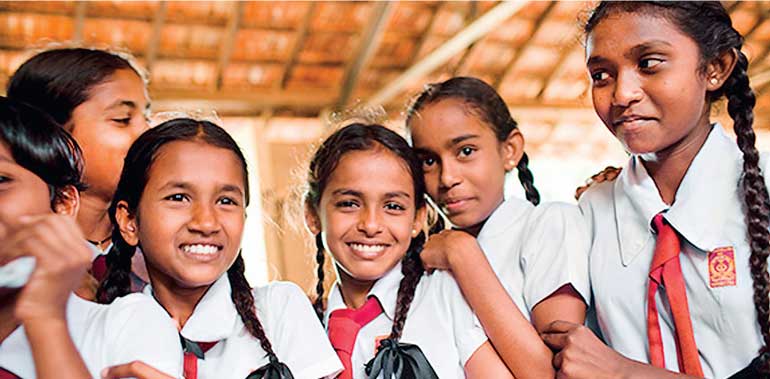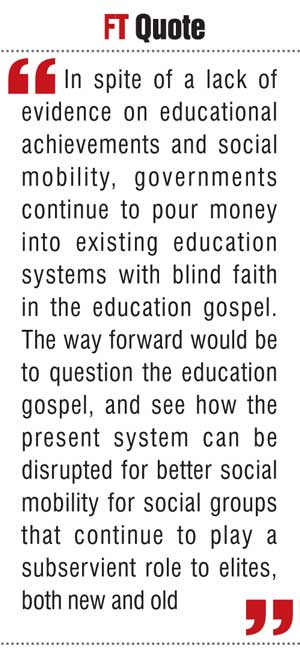Monday Nov 24, 2025
Monday Nov 24, 2025
Wednesday, 6 July 2016 00:10 - - {{hitsCtrl.values.hits}}

Free education may have served the purpose of politicians by keeping up a façade of equality, but it is time to take off our rose-tinted glasses and begin to look at the reality of education and social mobility in Sri Lanka, beginning with a better understanding of issues of social mobility in general
Whenever I travel out of Colombo visiting places from childhood, I am struck by what little education has done to bridge social classes. After more than 70 years of free education, the gran children of village headmen and the grandchildren of those who served the village headmen seem to be more or less in the same relative positions.
It seems both groups have moved horizontally within their social classes, but vertically, the groups seem as distant as, or more distant, than ever. As issues of social mobility are shaking up the developed world, we need to look at issues of social mobility in  our own backyard more closely.
our own backyard more closely.
According to the 2015 British Social Attitudes Survey by NatCen Social Research organisation, years of austerity and the end of a “golden age” of upward social mobility in late 20th century Britain may have been a major factor in the vote to Brexit. Across the Atlantic in the USA, Grusky and Mitnik, at the Center on Poverty and Inequality, use a new data set provided to them by the US Internal Revenue Service (IRS) to generate an IGE, or an intergenerational elasticity indicator.
An IGE can be between 0 and 1, with 0 representing total economic mobility and 1 representing the absence of it. If IGE is equal to 1, all parental income advantages in a society are passed onto the next generation in the form of higher earnings with no room for social mobility. In the past, estimates of IGE in the United States have ranged from 0.34 to 0.6, but Grusky and Mitnik’s numbers suggest its closer to 0.6. There are many other measures of social mobility, but the message is clear: investments in public education and other programs notwithstanding, the best bet for success is to be born to wealthy parents.
In Sri Lanka, there is little research on social mobility, but the link between education and social mobility is assumed. As a former Prime Minister remarked at a South Asian Association for Regional Cooperation (SAARC) forum, “Free education has to a great extent contributed towards social equity and upward social mobility in Sri Lanka. Poverty is no bar to education in Sri Lanka, because not only the schools and the teaching but also books and school uniforms are provided free by the State” (SAARC, 28 March 2009).
Free education may have served the purpose of politicians by keeping up a façade of equality, but it is time to take off our rose-tinted glasses and begin to look at the reality of education and social mobility in Sri Lanka, beginning with a better understanding of  issues of social mobility in general.
issues of social mobility in general.
Social mobility
Sasanka Perera, a professor of sociology, describes two different kinds of social mobility:
[Social mobility] functions on one of two levels: horizontal mobility and vertical mobility. Horizontal mobility refers to the movement of a person from one social position to another within the same rank. For example, a middle class person might become richer over time through business and he might be able to acquire more expensive goods like a car or more fashionable clothes that would mark his transition to another social position. But despite this, his overall class position might not change because whatever change that has taken place, has occurred within the existing rank which in this case is his class position. Vertical mobility refers to the movement of a person from one social position to another of a different rank. For instance, let’s take the same example as above. After considerable time and after acquiring more social skills and practices such as learning English, acquiring membership in exclusive clubs and moving into expensive neighborhoods, the same person might be able to move to a higher class position. This has happened often in Sri Lanka with regard to people who have excelled in education and business [Perera, 2011].
Unfortunately the vertical mobility Sasanka Perera describes has not been captured more quantitatively in the case of Sri Lanka. What he describes as ‘often’ could very well be an anecdotal few. If studies from the west are an indication, the observations that I made at the beginning of the article about apparent lack of vertical social mobility is more likely to be the general case in Sri Lanka.
Social mobility over time
In his review of the book titled ‘The Son also Rises’ by Gregory Clark, Jonathan Friedman says:
“How much of our fate is tied to the status of our parents and grandparents? How much does it influence our children? More than we wish to believe. While it has been argued that rigid class structures have eroded in favour of greater social equality, ‘The Son Also Rises’ proves that movement on the social ladder has changed little over eight centuries. Using a novel technique--tracking family names over generations to measure social mobility across countries and periods--renowned economic historian Gregory Clark reveals that mobility rates are lower than conventionally estimated, do not vary across societies, and are resistant to social policies. Clark examines and compares surnames in such diverse cases as modern Sweden and Qing Dynasty China. He demonstrates how fate is determined by ancestry and that almost all societies have similarly low social mobility rates. Challenging popular assumptions about mobility and revealing the deeply entrenched force of inherited advantage, ‘The Son Also Rises’ is sure to prompt intense debate for years to come”
One of more important points for debate is the role of education in social mobility, in particular what Grubb and Lazerson (2007) called the education gospel or the notion that more schooling for more people is the remedy for all our social and economic problems. This education gospel has come to pervade popular thinking and policy making, but, as the authors argue, paradoxically, it has reinforced social inequality.
Role of education
In 1964 the United States Congress ordered the U.S. Commissioner of Education to investigate “the lack of availability of equal education opportunities for individuals by reason of race, colour, religion, or national origin”.
The Coleman Report (1966) is the result. It was a national study of 600,000 students, 60,000 teachers, and 4,000 public schools that attempted to relate family background (including race and socioeconomic status) and school equity variables (including the integration of white and African-American children) to students’ test results and their attitudes toward attending higher education.
Coleman found, surprisingly, that students’ test outcomes were unrelated to the usual characteristics of schools (e.g., the quality of school facilities, programs, and teachers). Instead, the improvement in academic results among minority children was significantly linked to the quality of the student body– as measured by the proportion of students with encyclopaedias in their home and the proportion with high aspirations.
He wrote, “These minority children have a serious educational deficiency at the start of school, which is obviously not a result of school; and they have an even more serious deficiency at the end of school, which is obviously in part a result of [a segregated] school” (1966, p. 22).
Racial integration was, according to this study, the key social factor in improving student outcomes. As we know today, the policy of forced integration of schools was one of the factors leading both white and black parents with education or wealth to flee the cities to the suburbs, which were more homogeneous in wealth or education levels of parents.
Here in Sri Lanka in a survey conducted in 1978, Chandra Gunwardena, a professor at the Open University of Sri Lanka, noted that although the respondents’ economic status corresponded with highest education qualification, the latter was in turn is influenced by socio economic status of the father. More recent data from a household income and expenditure survey show educational achievement of youth to be more or less reasonably distributed across income groups (Youth and Development Report, 2014), but the link, if any, between educational achievement indicators and socio economic status has not been explored.
In spite of a lack of evidence on educational achievements and social mobility, governments continue to pour money into existing education systems with blind faith in the education gospel. The way forward would be to question the education gospel, and see how the present system can be disrupted for better social mobility for social groups that continue to play a subservient role to elites, both new and old.